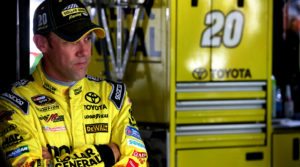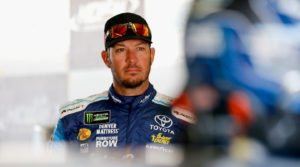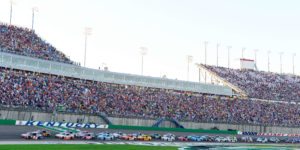“We don’t want to be a part of the story.”
Those were the words of Steve O’Donnell, who serves as Vice President of Racing Operations for NASCAR…and boy did he jinx the organization.
The Federated Auto Parts 400 at Richmond Raceway last Saturday night served as the final regular season race of the 2017 Monster Energy NASCAR Cup Series campaign. Ever since the series has adopted more of a playoff-based system (presumably to be more similar to the ‘normal’ sports) this event has always been the cutoff for the series’ playoffs. And while the possibility of drama and excitement has always surrounded this particular race–thanks, mostly, to the “win and you’re in” playoff berth rule–the night race at Richmond has typically remained calm, with no major changes happening to who the official playoff contenders are both before and after the race.

No surprise drivers clinched a playoff spot in this year’s regular season finale either, but that’s not to say that Saturday night’s race wasn’t drama-filled, to say the least. It all started with a caution flag thrown in lap 88, with just 12 laps remaining in the first Stage. Matt Kenseth, who has yet to win this season but would need to have a disastrous night to not make the playoffs on points, was well on his way to winning a stage (and getting a coveted playoff point), when he over-drove a turn and locked up his brakes, putting a giant puff of smoke on the track. NASCAR responded with a knee-jerk reaction: throwing the caution flag despite there being no imminent threat to driver safety on the track.
Kyle Busch went on to win the Stage and grab another playoff point. And while the caution flag left many NASCAR fans scratching their head, it’s hard to harshly criticize race control in that situation. Initially, because of how much smoke came from Matt Kenseth’s car, I thought it looked like the #20 Toyota’s engine blew, which, if that was the case, would have put down oil on the track and could have really caused some problems. With the speed that these Monster Energy Cup Series cars go, safety is still at the top of the list in terms of important things to keep in mind on race day. Or maybe being overly-cautious was just a little bit of foreshadowing for what was going to happen later.
On lap 257 of the 400-lap race, Austin Dillon got into the back of Danica Patrick and sent her #10 Ford spinning. Surprisingly, Danica was able to keep her car from hitting the wall, immediately continuing on. Of course, this brought out the caution, and it’s customary for NASCAR to send out an ambulance whenever there’s a car stopped on the track.
Eventually pit road was opened for the lead lap cars to pit, and all of them chose to do so. There was just one problem: the ambulance came to a stop at the entrance to pit road, causing a pileup of race cars. And unfortunately for Matt Kenseth, his car was the most affected, as the #20 Toyota went slamming into the back of Clint Bowyer’s #14 Ford, damaging the radiator.
A legitimate race contender soon found himself in the garage with unrepairable damage, and Matt Kenseth would end up being credited with a 38th-place finish. Additionally, NASCAR seemed to have some explaining to do, although the Joe Gibbs Racing driver was very professional about the whole situation when interviewed by NBCSN soon after.
Bizarre? Yes. Was that all that happened, though? Nope.
Fast forward to the final laps of the race–two to go, to be exact–and Martin Truex, Jr. is dominating, well on his way to his fifth win of the 2017 season, when the caution flag flies again. This time, Derrike Cope, who was many laps down in 36th-place, brushed the wall, and it would seem like NASCAR once again threw a knee-jerk caution.
Kyle Larson would end up getting the lead after pit stops, and Martin Truex, Jr. would end up getting wrecked by Denny Hamlin on the final lap, sending the #78 Toyota into the wall in what was described by Brett Griffin, spotter for Clint Bowyer, as the “[second] or third hardest hit [he’s] ever seen anyone take it [sic] Richmond.” Sherry Pollex, girlfriend of Truex, said “another [bullshit] caution…almost killed someone.”
Kyle Larson ended up winning the race, and that was probably the best thing to happen for NASCAR on Thursday night, as Joey Logano–who did not make the playoffs this year–finished 2nd. If Logano would have somehow found a way to win last Saturday night, that not only would have clinched him a spot in the playoffs, but it would have knocked Matt Kenseth out of championship contention–and possibly would have actually drawn some criticism out of some drivers.
Lack of Consistency…and Emotion

Martin Truex, Jr. was the only driver that was somewhat visibly upset after the conclusion of Saturday night’s race, but even the subdued-yet-pissed off interview from the driver wasn’t enough for casual fans to notice that calls were botched during the race. And there’s another, smaller problem that NASCAR has on its hands: minimal personalities within the sport. But we’ll get to that later.
The caution flag for Derrike Cope running into the wall–who Truex said shouldn’t have even been out on the track–cost the #78 team yet another win this season, but NASCAR’s reaction was the exact opposite of what we saw from race control just one week ago at Darlington.
In the final laps of this year’s Southern 500, Martin Truex, Jr. was in the lead but had very old tires at a track that is very rough on rubber. Denny Hamlin, who was charging hard for the win with fresher tires, got a little gift in the form of a blown tire, as Truex’s #78 Toyota went slamming hard into the wall and allowing Hamlin to take the lead and eventually get the win.
However, no caution was thrown at Darlington, and that car-in-the-wall incident was significantly worse than what we saw at Richmond on Saturday night. Not only did was Truex’s hit at Darlington a harder impact than Cope’s at Richmond, but the former spread visible debris on the track. The latter did not.
And therein lies one major problem with NASCAR: lack of consistency.
Despite the fact that Steve O’Donnell believes that NASCAR has been consistent with their calls this year, that simply has not been the case. In addition to not calling a caution for the exact same, if not worse happening just one week later, NASCAR was also inconsistent with penalties for pit road commitment line violations on Saturday night.
Yep, if you remember back to the first race at Richmond this year in late April, a very similar situation happened with an safety vehicle. In that race, several drivers–including Martin Truex, Jr., who has to just hate the track because of his bad luck–swerved to miss a safety truck near the entrance of pit road and were soon hit with commitment line penalties. The exact same thing happened last weekend at Richmond with the ambulance near the pit road entrance but NASCAR did not issue any penalties because of it.
A Precedent Was Already Set

“Fixing” races is something that NASCAR has been accused of for many years, and that accusation is something that isn’t going to stop. And saying that the racing organization makes a blatant effort to try and award certain drivers victories is a bit outlandish. But what if we used a lighter term to describe their efforts…how about, “manipulation.”
With caution flags coming at the sole discretion of NASCAR officials, those people absolutely have the ability to manipulate the ending of a race. It’s no secret that a late-race caution–and subsequent restart for the race win–creates drama and entertains the crowd. What it comes down to is whether or not those officials exercise those powers–and this isn’t the first time this season that a race has ended under questionable circumstances.
Remember back to less than two months ago at one of the biggest races of the season: the Brickyard 400 at the famed Indianapolis Motor Speedway. After a late afternoon start–another questionable decision by NASCAR this year–and rain delay, one of the sport’s biggest races was in the final laps and running out of daylight quickly (Indianapolis doesn’t have lights). After a plethora of earlier wrecks, a pileup occurred yet again on the backstretch during an “overtime” attempt.
The rule for the race to end and a winner be declared (at that time, it was changed a few races later) is that the leader must cross the “overtime line” before a caution is thrown. However, when the wreck occurred at Indianapolis, the leader, Kasey Kahne, was nowhere near the overtime line. And instead of throwing a caution in trying again–per the official rules of the sport–NASCAR decided to deliberately delay the caution being shown until the leader crossed the overtime line. My initial knee-jerk reaction on Twitter was as follows:
NASCAR manipulated the end of that race. Running out of daylight, they waited to throw that caution.
— Jordan McAbee (@FanRacingOnline) July 24, 2017
This delayed action by NASCAR showed that not only did they have the ability to manipulate the ending of a race, but that they would blatantly use that power as well. I was immediately met with acceptance and defending of NASCAR’s decision, with many people saying that it was getting so dark that that was how the race would have ended anyway. Again–not the point; NASCAR showed a clear disregard for their own rules, and they did not care how it looked.
Some people are saying it would've ended like that anyway.
My point is NASCAR has the free will to manipulate finishes. Precedent set. https://t.co/RbISkZMWVA
— Jordan McAbee (@FanRacingOnline) July 24, 2017
The Affect on Ratings and Attendance
 It’s no secret that NASCAR’s ratings have been, and still are, in a major decline. As is the actual attendance to the races, although we have no way of tracking that anymore because the tracks decided to stop releasing those numbers. However, we do have ratings, and FOX, which handled the broadcasting of the first part of the 2017 season, saw a 12% decline in ratings when comparing this season to last.
It’s no secret that NASCAR’s ratings have been, and still are, in a major decline. As is the actual attendance to the races, although we have no way of tracking that anymore because the tracks decided to stop releasing those numbers. However, we do have ratings, and FOX, which handled the broadcasting of the first part of the 2017 season, saw a 12% decline in ratings when comparing this season to last.
The Southern 500 at Darlington–one of the most historic races on the schedule–earned just a 1.8 rating and 3.1 million viewers on Labor Day weekend, down 36% and 33% (respectively) from the previous year. Now, a large part of that decline is due to the fact that the race was broadcast on NBCSN instead of NBC, but the overall dwindling of the ratings is something that NASCAR needs to fix–and fast.
Up until this season, Sprint served as the main sponsor of the NASCAR Cup Series, as they decided to leave the sport after their ten-year deal expired. It was expected that Sprint paid somewhere between $50 and $75 million per year to be the main sponsor the series. However, it took nearly two years after Sprint publicly announced its plans to leave that NASCAR found a new sponsor.
Enter Monster Energy. And while NASCAR hopes the deal will bring a more youthful crowd to NASCAR, details of the agreement were not disclosed, other than the fact that it is a “multi-year deal.” Rumors were swirling, though, that Monster got a significant discount on the deal, as NASCAR was coming down to the wire as far as finding a title sponsor. Additionally, potential sponsors are well aware of the sport’s declining base.
As far as the actual racing on track, though, it seems to be improving. The sport has a great rush of young talent emerging as stars, and although most, if not all of them lack a personality–they’re essentially just walking billboards–the young guns sure know how to put on a good race. Also, with the addition of Stage Racing and playoff points, NASCAR has hit a home run in how the races are set up each and every week–at least in my opinion.
So why are ratings going down?
Maybe the ratings are down because NASCAR is obsessed with fans getting excited over the excitement on the track, which is the exact reason why we constantly see ads showcasing the wrecks and the beating and banging on track that those fans cheer for. Yet when the beating and banging actually occurs, NASCAR rules with an iron fist, and either places the driver on probation or suspends them entirely (once again, Matt Kenseth).
Or maybe, just maybe, it has something to do with what we saw last Saturday night. Maybe the longtime NASCAR fans are tired of the inconsistent rulings and countless bogus cautions that are thrown near the end of the race in a (presumed) attempt to create more drama–or to avoid bad press. Don’t forget NASCAR’s handling of Kurt Busch’s near win at Fontana back in 2015 soon after he was accused of domestic violence (read here).
The first NASCAR race I attended was at Kentucky Speedway, and there was a debris caution thrown while Kyle Busch was just running away with the race. I watched the safety truck come on the track and a worker get out, but the guy didn’t pick up a single piece of debris–because the debris wasn’t there.
I don’t believe in coincidences, especially when those coincidences have a monetary effect on a company. And with the amount of conveniently-timed cautions that NASCAR fans regularly see–whether they’re for debris or someone’s brakes smoking too much–that are the perfect timing for there to be added drama for that particular race, it’s hard to sit back and think that these races aren’t being purposely manipulated whenever it can be argued to be authentic. Kurt Busch called it WWE back at Fontana in 2015, and Cole Pearn, crew chief for Martin Truex, Jr., said the same thing after last Saturday night’s race in Richmond:
https://twitter.com/colepearn/status/906716198141923328
Be authentic, NASCAR. It’ll be a great start in fixing many of the problems you have going on right now. And let your drivers be authentic, too. Every hero needs a villain, and right now the latter is lacking in a major way.

















Exactly!!! This is why my interest in NASCAR is just about reached it’s end. I rarely even watch the races live any longer. As a racing fan since the early sixties I have been very disappointed in the turn NASCAR has taken over the last several years. F1, Indy, hell even IMSA put on a much better show for by race watching time. It’s just a damn shame what they have done to this once great sport. When they let them race, like you said, the racing is great, sad they have to throw the yellow “race manipulation” flag to suit what they think the fans want to see, (WWE?) Great article Jordan, spot on! ofr
Some races I have noticed the time allotted by tv and then Nascar trying to end the race in that allotted time ergo no yellow flags. TV pays well. What happened at Richmond with the ambulance is something that shouldn’t have happened and looked like a clown show. The late yellow flags and blaming Nascar is fair game but still it is in the driver’s hands not to overdrive and wreck drivers.
Howdy Jordan, Great article. You covered all the points that I’ve complained about over the year. When will NASCAR get their head out of their a$$? I love the new format with stage racing, but the manipulation with phantom debris, and other things NASCAR has done to blatantly change the race has even made this arden fan wonder if NASCAR can reverse the downfall. I was hoping the stages would garner new fans, but it saddends me that I think the ship is sinking. When I was reading your article, just before you mentioned WWE, I was thinking the samething. On another point NBCSN does not air all the practices, this coming weekend, too. Their app’s sound goes in and out so it useless, and if you start to watch it later than it started, it will end before you have finished watching it. There is not an option to replay the practice. I had to throw in my 2 cents on that. I really wish NASCAR would not allow NBCSN to cover NASCAR anymore. Keep up the great work.
Nice write-up Jordan – You covered many of the same topics I commented on why I filled out my weekly survey for the NASCAR Fan CouncilI didn’t mince words and stated the same things you said here – Fans are tired of races being manipulated and bogus yellows being throw just to bunch up the field and create “drama”.
As a long time NASCAR fan I used to always say I loved that the sport pretty much couldn’t be “fixed”. Back in the day it was common to have blown motors; part failures, etc> Thus it was about impossible to see to it that a certain driver won.
These days with motors that are virutally bullet-proof, and rarely have parts failures; NASCAR HAS decided they can have a hand in who wins. I AM CONVINCED that if Dale Jr had ever put a good race together and been running hear the front at some point near the end of a race – they would of throw a yellow to give their ‘golden boy’ a shot at winning.
I also complained about NBC’s coverage and how they never show the ‘crawl’ that shows the running order AND it including how far BEHIND the leader all the other drivers are (But that’s a bitch for another day)